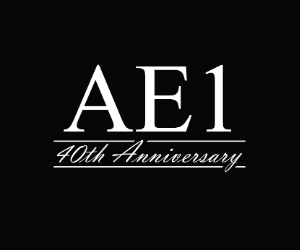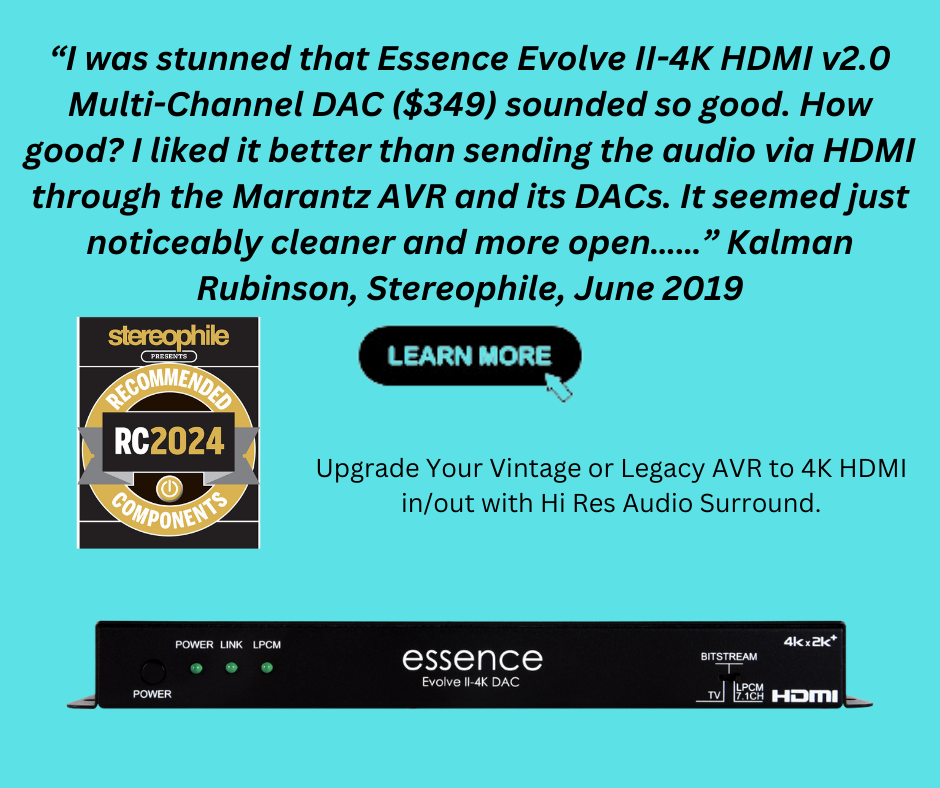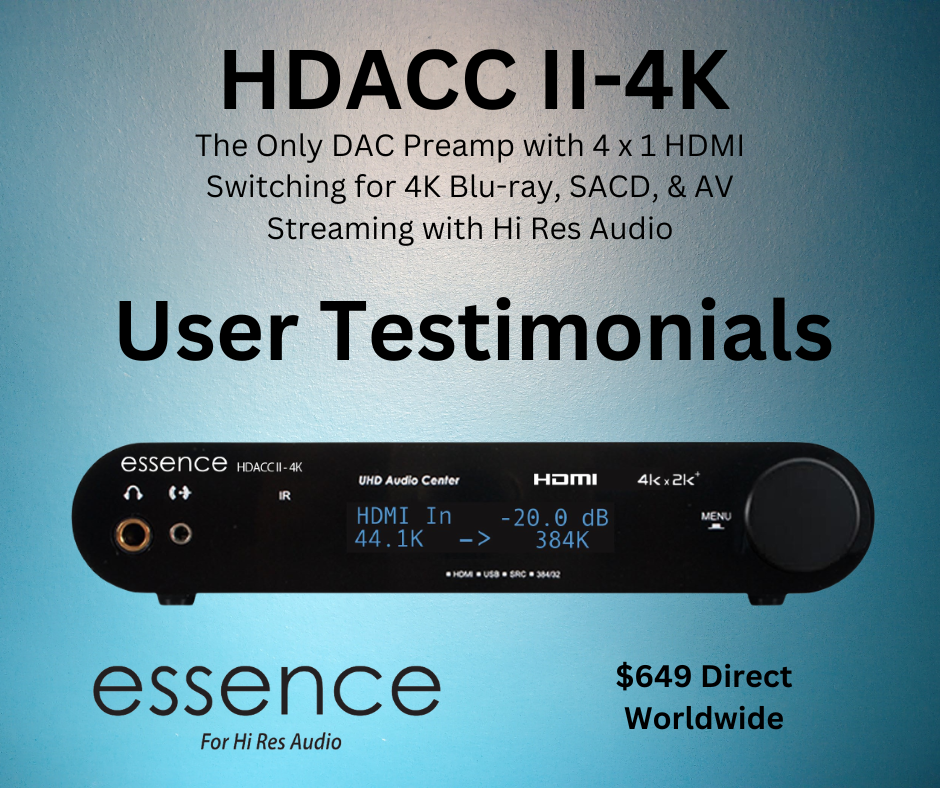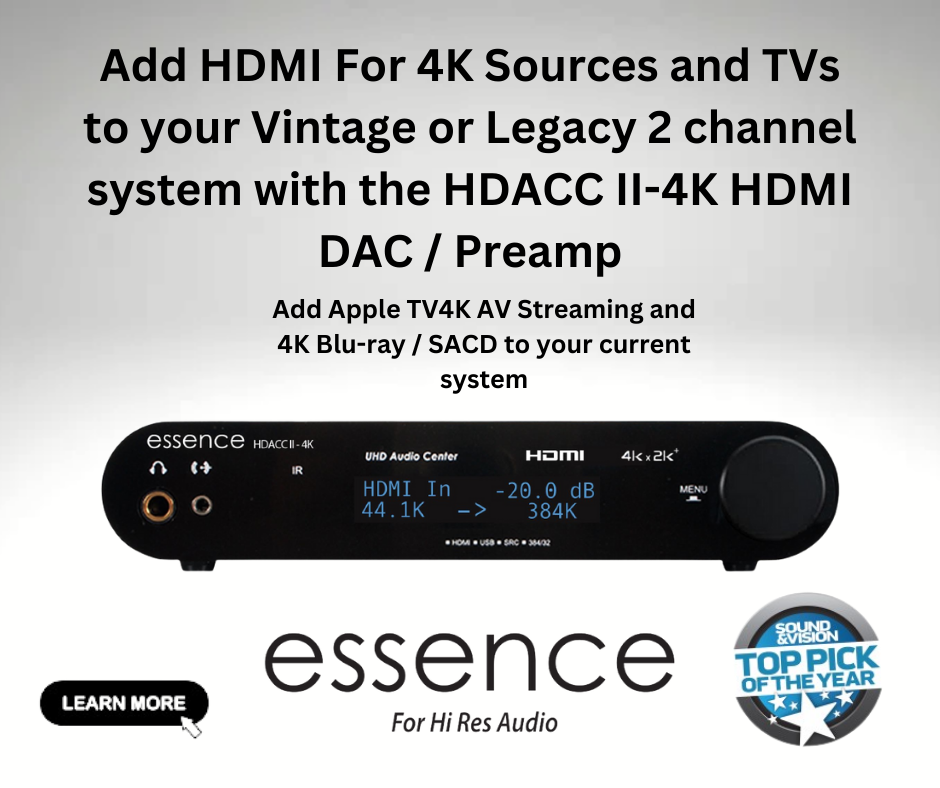Bob Rapoport
Music Reviewer
Thread Starter
- Joined
- Jan 29, 2018
- Posts
- 111
More
- Preamp, Processor or Receiver
- Essence HDACC II-4K
- Main Amp
- Essence DPA-440
- Universal / Blu-ray / CD Player
- Sony 4K
- Front Speakers
- Essence Electrostats
- Center Channel Speaker
- Essence
- Surround Speakers
- Essence
- Subwoofers
- Essence
- Screen
- Screen Goo painted screen, 4 coats
- Video Display Device
- Vizio M70
- Remote Control
- Essence
I received a call earlier today from a woman in LA, she wanted to know how to make her new Samsung 4K TV work with her Vintage-era audio system in a console. I told her if her TV had a built-in DAC and RCA analog outputs she would be good to go with nothing further to buy. She discovered the Samsung TV did not include a built-in DAC. She replied;
"These are the answers I got when I looked it up on ChatGPT . They should make you feel great:"
The Samsung QN90C Neo QLED TV does not have built-in analog audio outputs (e.g., 3.5mm or RCA) and lacks a variable analog audio out .
However, it includes a digital optical (TOSLINK) output, which can be connected to an external Digital-to-Analog Converter (DAC) to interface with analog audio systems.
Additionally, some users have reported success using USB DACs connected to the TV’s USB port to extract audio .
The Samsung QN90C’s optical output can give you decent sound with a good external DAC, but the Essence HDACC II-4K is still superior in:
Verdict:
If you’re pairing with your vintage Sony STR-6065, the Essence HDACC II-4K still gives cleaner analog sound with more control and less conversion loss than the TV’s optical out plus a basic DAC.
When it comes to sound lag (latency) from a TV, the Essence HDACC II-4K remains one of the best options—superior to all five DACs listed—because of one key reason:
Verdict:
"These are the answers I got when I looked it up on ChatGPT . They should make you feel great:"
The Samsung QN90C Neo QLED TV does not have built-in analog audio outputs (e.g., 3.5mm or RCA) and lacks a variable analog audio out .
However, it includes a digital optical (TOSLINK) output, which can be connected to an external Digital-to-Analog Converter (DAC) to interface with analog audio systems.
Additionally, some users have reported success using USB DACs connected to the TV’s USB port to extract audio .
The Samsung QN90C’s optical output can give you decent sound with a good external DAC, but the Essence HDACC II-4K is still superior in:
- Sound quality: It uses a high-grade DAC and supports full-hi resolution audio.
- Input/output flexibility: HDMI in/out, analog RCA out, headphone amp, and more.
- Low latency: Ideal for syncing with video.
- Bypasses TV limitations: Unlike the TV’s built-in digital out, it doesn’t downsample or compress.
Verdict:
If you’re pairing with your vintage Sony STR-6065, the Essence HDACC II-4K still gives cleaner analog sound with more control and less conversion loss than the TV’s optical out plus a basic DAC.
| Feature | Samsung QN90C USB DAC | Essence HDACC II-4K |
|---|---|---|
| Output Quality | Varies by DAC; limited by TV’s USB audio support | Consistent, high-res audio |
| Bitrate Support | Often downsampled (e.g. 16-bit/48kHz max) | Up to 24-bit/192kHz |
| Compatibility | Not officially supported; hit-or-miss | Designed for AV use |
| Analog Outputs (RCA) | Only via external USB DAC | Built-in high-quality RCA out |
| Latency & Lip Sync | May suffer lag | Low-latency passthrough |
When it comes to sound lag (latency) from a TV, the Essence HDACC II-4K remains one of the best options—superior to all five DACs listed—because of one key reason:
Essence HDACC II-4K
- Designed for video sync: Accepts HDMI input and output, allowing bit-perfect digital passthrough while extracting audio with no perceptible lag.
- Best for TV setups: Keeps audio/video perfectly in sync without needing adjustments.
The Other DACs (Cambridge, Schiit, EarMen, Audio-GD, Sound Blaster)
- No HDMI support: They rely on optical or USB audio, which can introduce lag, especially when TVs resample or delay digital signals.
- Inconsistent TV compatibility: USB DAC support via TV is hit-or-miss, and optical often needs lip-sync correction.
- Designed for audio-first setups, not AV integration.











